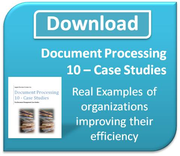Business processes have long been paper dominated systems. Until the advent of computerized process systems some time ago everything that drove the operations of most businesses relied on pieces of paper to flow within and outside of a business for it to succeed.
With the advent of the fax machine in the early eighties this started to change as finally there was a means to transform a hand written our typed document to an electronic format for transmission and then turn it back into a paper based document (facsimile) for processing. In some industries in spite of advances in technology this is still a dominate process.
Growth of digital documents
Since the development and dominance of desktop computing and the advent of the internet as a primary business communication tool documents have been transforming into a digital form. The processes around them however have not necessarily followed the trend and in many instances paper still dominates.
Digital Flip Flop
When paper processes and digital document processes start to conflict they can lead to  the development of various forms of 'digital flip flops' in order for the necessary business steps to occur. There are many scenarios which can lead to this trend. Consider a few common actions and how the manner in which documents are created and communicated can lead into flip flops.
the development of various forms of 'digital flip flops' in order for the necessary business steps to occur. There are many scenarios which can lead to this trend. Consider a few common actions and how the manner in which documents are created and communicated can lead into flip flops.
Example - Invoicing and payment
Many organizations have turned to electronic invoicing to save costs in print production and in mailing. Instead of issuing customers a paper invoice they use either a form of electronic message with a link to an online invoice, or more commonly especially in SMBs they will forward a PDF copy of an electronically generated invoice to the customer.
Depending upon the processes used at the receiving end this is where the flip flops can begin. If the customer is still using paper processes for invoice authorization and payment they must print the digital invoice, make copies if needed and route for approval and payment. This is the 'FLIP'. If their system is still fully paper based there may not be a 'FLOP' as the records are stored in paper filing and the process ends.
The 'FLOP' comes in this instance when the paying company uses an electronic means for storing the paid invoices, payment documents and other supporting records. Usually this requires scanning a copy of the processed paperwork and filing it away either in a foldering system or maybe some form of document management system.
In this scenario a digitally received document is converted to paper, processed for payment then stored in digital format. A Flip and Flop.
There are multiple various interations of this kind of action. Until and organization modifies their processes to handle information in one form, ideally electronic and gets everything converted to that form early in the process these kinds of flip flops will continue.
Storing in paper with digital documents
Another scenario that can create the flip and flop confusion is when a business operates in two modes at once. Perhaps they have moved to a fully functioning ERP system that handles the flow of information through their business, however they are still receiving paper documents from their customers or suppliers and have not developed a way to handle them directly. The FLIP comes as these documents are either manually entered into the ERP or perhaps a scanned copy is attached in some manner.
The information then flows through the business process as required and finally reaches an end point. Here's where the FLOP can occur again. How does the process deal with storing source documents, internally generated supporting documents and finally the end set? Is the document set printed out for paper storage? Or is there a way to handle it organized electronically? What if both are present?
What kind of procedure or search capability is available? This kind of hybrid operating system is most likely the most common circumstance that is experienced right now. Many businesses have started into a digital transformation for part of their operations but still maintain partial paper based systems as well.
This situation is especially present in SMBs since making this kind of structural change requires planning and manpower something that is often a challenge for many smaller organizations. Even at the enterprise level recent reports show that only about 40% of Canadian enterprises have embraced and are implementing digital transformation strategies. For the balance some planning is underway but implementation is still to come.
For smaller organizations this is an area which is most likely not even on the horizon, although they still have to struggle with the challenges created by the shifts.
The Digital Flip Flop is something that many businesses have not identified as yet even though daily their employees are being asked to operate with these kinds of impediments to productivity. Take a look at how information flows through your organization. Is it constantly being transformed to fit into a previously common but increasingly challenged methodology? Perhaps identifying your Flip Flops can help reduce stress and speed up information flow. It also may save costs of handling and avoid errors. All benefits that come with a streamlined and consistent system.
Lee K
Photo credit: By Katy Warner from Orlando, FL, USA [CC BY-SA 2.0 (http://creativecommons.org/licenses/by-sa/2.0)], via Wikimedia Commons




